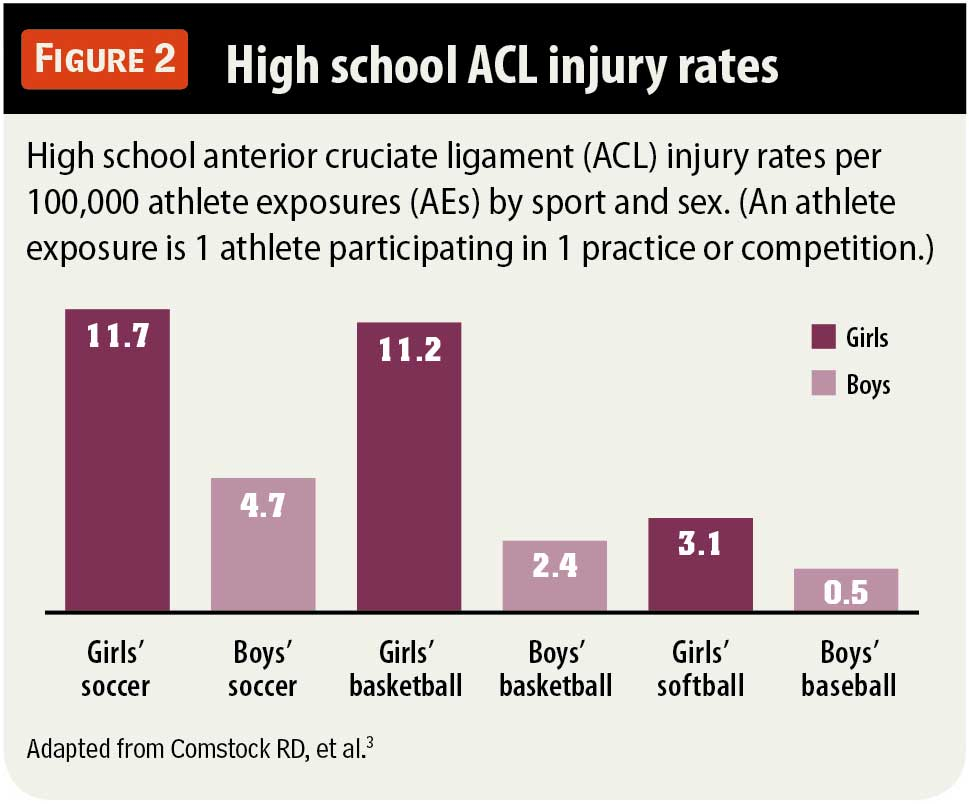ACL injury rates in women athletes have become a pressing issue in the sphere of sports science, drawing attention to the alarming disparities in injury occurrences among female competitors. Research highlights that women are 1.7 times more likely to suffer ACL injuries compared to their male counterparts, which raises critical questions about underlying ACL injury risk factors. Factors such as team sizes, hormonal variations, and training conditions contribute significantly to higher injury rates for women athletes. The complexities of gender disparities in sports not only shed light on biological factors but also emphasize the impact of social structures and resource allocation that often disadvantage female athletes. Understanding these dynamics is essential in developing effective ACL injury prevention strategies that can bridge the gap between male and female athletes, ensuring safety and fair play across all sports.
The discussion surrounding anterior cruciate ligament injuries among female sports participants indicates a concerning trend that necessitates our attention. The elevated incidence of knee injuries, particularly among women athletes, underlines the necessity of examining both physical and socio-economic influences that contribute to women’s sports injuries. Issues such as varying team rosters, differences in training regimes, and access to injury prevention resources have profound implications on injury statistics. By addressing the intersection of gender and sports science, we can uncover valuable insights that not only reflect the reality of injury rates but also highlight potential areas for intervention. Thus, fostering a comprehensive understanding of how gender affects sports performance ultimately paves the way for improved athlete health and safety.
Understanding ACL Injury Rates in Women Athletes
ACL injury rates in women athletes have become a critical subject of discussion in sports science, with recent studies indicating that women have a 1.7 times higher risk of experiencing ACL injuries compared to their male counterparts. This disparity raises important questions about the factors contributing to these differences, not just biological ones but also social and structural. The traditional view often attributes this increased risk to anatomical differences, such as hip structure or hormonal influences on ligament strength. However, the findings from Harvard’s GenderSci Lab suggest that these explanations may overlook significant social dynamics that influence injury rates.
Researchers have highlighted that women athletes frequently train and compete with smaller team sizes, which can lead to increased exposure to injury due to limited player rotations and higher game intensity per individual. This means that as women’s teams typically have fewer substitutes, each player ends up participating in a greater percentage of games, thus facing a higher cumulative risk during those matches. Adopting a more nuanced understanding of ACL injury risk, therefore, necessitates a comprehensive approach that includes examining these social variables alongside biological factors.
Key Factors Contributing to Higher ACL Injury Rates
One major factor contributing to the higher ACL injury rates in women athletes is the underinvestment in women’s sports programs compared to men’s. Financial resources allocated to women’s sports often fall short, leading to less training time, poorer facilities, and reduced access to professional coaching and rehabilitation services. These disparities not only affect the quality of training but also the physical condition of female athletes, making them more vulnerable to injuries during competitive play.
Moreover, the structure of practice and competition schedules plays a vital role. Women athletes generally train less than male athletes due to limited roster sizes, partially resulting in a decreased opportunity for skill development and injury prevention strategies. This lack of comprehensive training regimens directly correlates to their higher injury rates, particularly in high-impact sports. As noted in the recent studies, proper conditioning is crucial in preventing injuries, underscoring the need for equitable training opportunities across genders.
Gender Disparities in Sports: ACL Injuries and Athlete Exposure
The exploration of ACL injuries among women athletes invariably ties back to the broader context of gender disparities in sports. The metrics often used for injury assessment, such as athlete-exposures, predominantly favor male sports contexts where larger teams and more substantial support structures exist. This bias can distort the data, painting an incomplete picture when comparing injury rates between genders. Inadequate consideration of how team sizes and competitive structures differ leads to a misunderstanding of the true risks women face in sports.
Addressing these disparities requires a shift in how sports injuries, particularly ACL injuries, are assessed. Researchers urge the incorporation of detailed evaluations of individual athlete exposures that differentiate between practice and game participation, taking into account factors like team size and the availability of medical support. Utilizing this richer data can help redefine injury rates more accurately, ultimately supporting better-targeted injury prevention strategies tailored to women’s sports.
Effective ACL Injury Prevention Strategies for Women Athletes
Preventing ACL injuries in women athletes necessitates a multifaceted approach that incorporates both physical conditioning and awareness of the social factors at play. Current research advocates for the adoption of specific training programs that enhance strength, flexibility, and overall conditioning, targeting the muscles around the knee to provide better support for the ligaments. Furthermore, educational programs highlighting the importance of recognizing risk factors and employing proper techniques during competition can empower female athletes to take proactive steps toward their health and safety.
Additionally, institutions and sports organizations need to invest more in women’s sports by providing sufficient resources and facilities that are on par with those given to men’s teams. This not only helps in creating better competitive conditions but also enhances the overall experience for women athletes, which could lead to increased participation rates and improved performance. By improving the training environment and ensuring adequate access to medical resources, we can significantly mitigate ACL injury rates among women athletes.
The Role of Social Factors in ACL Injuries Among Women Athletes
Social factors play a critical role in the prevalence of ACL injuries among women athletes. Underfunding in women’s sports, fewer training sessions, and inadequate conditioning programs contribute significantly to injury rates. Research from the GenderSci Lab emphasizes that these social inequities often intersect with biological variables, creating a compounded effect on injury vulnerability. Acknowledging these social determinants opens up pathways for targeted interventions that address both injuries and the conditions that contribute to them.
Moreover, fostering a culture that prioritizes equity in sports is essential. This can be achieved through policy changes aimed at ensuring equal funding, resource allocation, and training opportunities. By creating an inclusive environment that values women’s sports, we can reshape the narrative surrounding ACL injuries and better support female athletes in achieving optimal performance while minimizing their risk of injury.
Training and Conditioning: Essential Practices for Injury Prevention
Training and conditioning are paramount in preventing ACL injuries in female athletes. Implementing tailored strength and conditioning programs can help in fortifying the muscles that support the knee and reducing the likelihood of injuries. Specific exercises focused on balance, agility, and plyometric training have shown to be particularly effective at diminishing the risk of ACL injuries, as they help improve movement patterns considerably.
Additionally, it is crucial for coaches and trainers to be educated on the unique injury risks faced by women athletes. By understanding the specific risk factors associated with female athletes, trainers can customize training regimens that not only enhance performance but also prioritize injury prevention. Regular assessments and adjustments to training programs should be implemented based on the evolving needs of players as they progress through their sports careers.
Research Advancements in ACL Injury Analysis
Recent advancements in research analyzing ACL injuries shed light on the complexities surrounding the injuries faced by women athletes. Studies that employ comprehensive methodologies to evaluate risk factors beyond biological dimensions are paving the way for a more informed understanding of injury prevention. Innovative approaches that integrate sports science, epidemiology, and gender studies are critical in addressing the multifactorial nature of ACL injuries.
These research efforts focus on not only the biological aspects of ACL injuries but also consider how societal structures shape the experiences of female athletes. By utilizing a combination of quantitative data and qualitative insights, researchers can unravel the intricate tapestry of factors contributing to injuries, informing more effective prevention strategies that can be universally applied across various sports and activities.
Educational Initiatives to Raise Awareness About ACL Injuries
Education plays a key role in raising awareness about ACL injuries among women athletes. Implementing programs that inform athletes, coaches, and parents about the specific risks and prevention strategies can contribute significantly to reducing injury rates. Workshops and seminars designed to educate stakeholders on ACL health can empower female athletes to make informed choices about their training and competition.
Moreover, fostering a culture of open dialogue about injuries can encourage athletes to speak up about their experiences and challenges. By normalizing discussions around injury prevention and self-care, organizations can promote a healthier sports environment. Such educational initiatives should be integral to all levels of sports, ensuring that young female athletes receive the information and support they need to thrive safely in their athletic endeavors.
Implementing Policy Changes for Women Athletes’ Safety
To effectively address the higher rates of ACL injuries among women athletes, implementing policy changes at institutional and organizational levels is imperative. This involves advocating for equal funding for women’s sports, improving access to resources such as personal trainers and medical professionals, and ensuring that facilities meet the same standards as those used in men’s sports. Legislation aimed at promoting equal opportunities within sports can be powerful in driving change.
Furthermore, policies that prioritize the health and safety of female athletes should encompass comprehensive injury prevention programs, including regular assessments and modified training practices that account for the unique challenges faced by women. By fostering an environment where safety, health, and equality are prioritized, we can create a more balanced playing field that not only reduces ACL injury rates but also enhances the overall experience of female athletes across all sports.
Frequently Asked Questions
What factors contribute to higher ACL injury rates in women athletes?
Higher ACL injury rates in women athletes can be attributed to several factors, including anatomical differences, hormonal fluctuations, and social inequities in sports participation. Research indicates that smaller team sizes and unequal resource allocation contribute significantly to the increased risk of ACL injuries when compared to male athletes. It is essential to consider these gender disparities and their impact on ACL injury risk factors.
How do gender disparities in sports affect ACL injury prevention strategies for women athletes?
Gender disparities in sports lead to unequal training resources and opportunities, which can hinder effective ACL injury prevention strategies for women athletes. With less training time and inadequate access to proper conditioning, female athletes may face a higher risk of ACL injuries. Addressing these disparities through better funding, facility access, and injury prevention programs is crucial for safeguarding women athletes against ACL injuries.
What are the common ACL injury risk factors for women athletes?
Common ACL injury risk factors for women athletes include biomechanical differences such as hip and knee alignment, lower muscle strength, and differing movement patterns. Additionally, social factors like smaller team sizes, lack of extensive training sessions, and insufficient investment in women’s sports can exacerbate these risk factors, leading to increased ACL injury rates in female athletes.
How does participation level impact ACL injury rates in women athletes compared to men?
Participation level significantly impacts ACL injury rates in women athletes due to fewer roster spots and less time spent in effective training. Since women athletes train less frequently and for shorter durations compared to their male counterparts, their risk of injury is higher during matches. Thus, female athletes face greater ACL injury risks despite similar injury rates per unit of game time.
What improvements can be made to ACL injury risk assessments for women athletes?
Improvements to ACL injury risk assessments for women athletes include adopting metrics that separate practice time from game time, accounting for individual player exposure, and controlling for team sizes. Collecting more comprehensive data regarding facility access and athlete resources would enhance the understanding of environmental and social factors influencing ACL injuries among female athletes.
| Factor | Men | Women |
|---|---|---|
| Roster Size-based Athlete Exposures | 28 | 25 |
| Participant-based Athlete Exposures | 19 | 17 |
| Player-hours | 6 | 6 |
| Injury Rate per 100 Roster-based Athlete Exposures | 3.6 | 4.0 |
| Injury Rate per 100 Participant-based Athlete Exposures | 5.3 | 5.9 |
| Injury Rate per 100 Player-hours | 16.7 | 16.7 |
| Injury Risk per Team Member | 0.036 | 0.040 |
| Injury Risk per Participant | 0.053 | 0.059 |
Summary
ACL injury rates in women athletes are a significant concern, with research indicating that these rates are 1.7 times higher than those of their male counterparts. The study from Harvard’s GenderSci Lab challenges the traditional explanations that attribute this disparity solely to biological differences. Instead, it highlights how social factors, such as team sizes and fluid participation in competition, contribute to these elevated risks. A shift in how athlete exposure is measured and a focus on gender equity in sports resources could lead to more effective prevention strategies and improved outcomes for female athletes.




